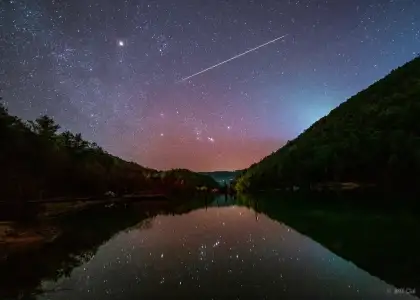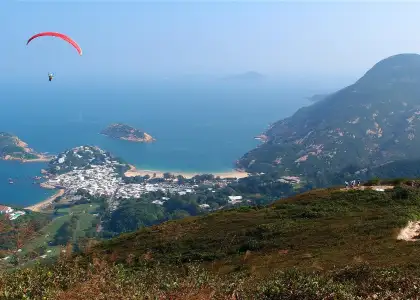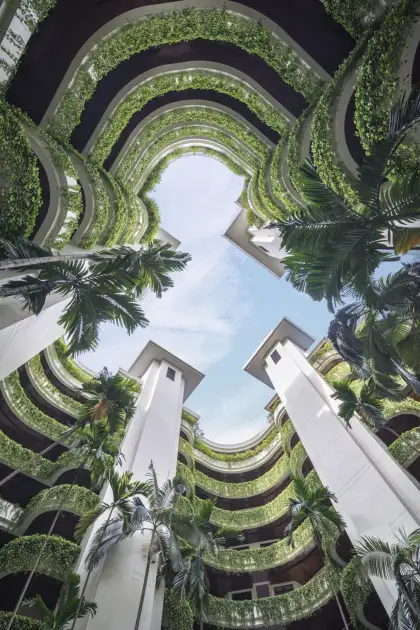Bloom and Breathe: Quick Garden Escapes in Southeast Asia
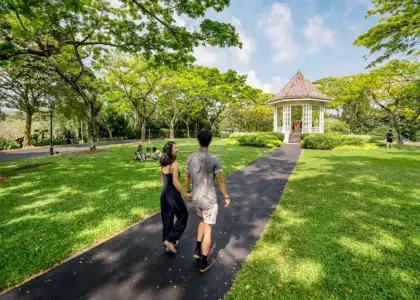
If you’re feeling a little bit overwhelmed with the daily rush of life, perhaps it’s time to take a brief reprieve — to stop and smell the flowers.
Asia is a treasure trove of stunning gardens that offer a peaceful escape from the city. Whether you’re craving a moment of stillness amid Zen rock gardens, wandering through lush tropical landscapes, or futuristic greenery, these gardens blend natural beauty with cultural charm.
Perfect for a quick day trip or weekend retreat, these green sanctuaries invite you to slow down, breathe deeply, and reconnect with nature.
Gardens By The Bay (Singapore)
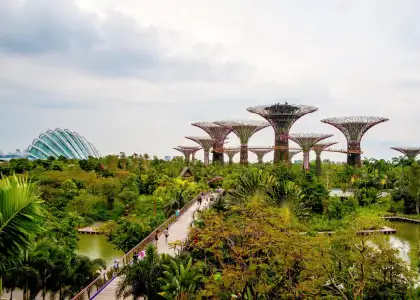
One of Singapore’s most iconic attractions, Gardens By The Bay, is unlike any garden you’ve ever seen and is a blend of lush horticultural artistry and cutting-edge architecture.
Its most iconic feature is the Supergrove Trees, towering over the area like spaceships. At night, they come alive with a light and sound show, making them both eco-friendly and visually stunning. Another must-visit area is the Cloud Forest, which houses a massive indoor waterfall and a selection of rare flowers and plants. The place is designed to raise awareness about biodiversity and climate change, and mimics the environment of the tropical highlands.
For flower enthusiasts, don’t miss the Flower Dome, the world’s largest greenhouse that serves as a conservatory for plants and flowers from the Mediterranean and semi-arid regions around the world. The dome also features seasonal floral displays throughout the year, such as their annual Sakura (Cherry Blossoms) event.
We recommend getting a ticket that gives you access to both the Cloud Forest and Flower Dome. Prices are at S$32 (Adult, non-resident), S$20 (Adult, resident), S$12 (Child, resident), and S$18 (Child, non-resident).
A presale is also ongoing for the upcoming Jurassic World: The Experience event, which will feature life-size dinosaur animatronics and ancient plants at Cloud Forest. Access tickets are S$46 (Adult) and S$32 (Child). You can learn more about their current events and guided tours on their official website.
Location: 18 Marina Gardens Drive, Singapore
Operation Hours: 9 AM to 9 PM. Other areas may have different openings and closures. Learn more about it here.
Admission Fee: Standard adult tickets for the Cloud Forest start at S$12 and S$8 for children. Additional fees apply for entries to other areas. Upon purchase, e-tickets are included in the email you registered with. You can buy tickets here.
Follow them on Facebook, X (Formerly Twitter), and Instagram.
Singapore Botanic Gardens (Singapore)
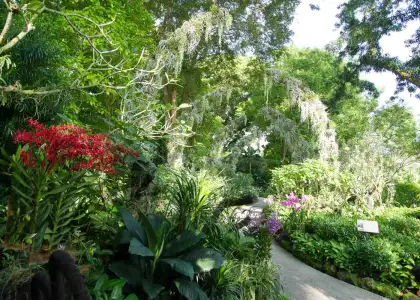
Another garden located in Asia’s Green City is Singapore Botanic Garden, which is a UNESCO World Heritage Site founded in 1859. This lush tropical garden is the country’s oldest garden and houses the world’s largest orchid display with over a thousand species and 2,000 hybrids.
The destination also features a lake with swans, fish, and aquatic plants that make for serene strolls or picnic spots. It’s also Asia’s first garden dedicated to children and protects a small patch of primary rainforest and heritage trees.
If you’re looking for a place where you can immerse yourself in history, culture, beauty, and science, this is it. You can learn more about their guided tours and educational programs here.
Location: 1 Cluny Rd, Singapore 259569
Operation Hours: 5 AM to 12 AM daily.
Admission Fee: Free. Some areas may require fees, such as the National Orchid Garden, which is priced at S$5 (Adult, resident), S$15 (Adult, non-resident), S$1 (Student, resident), and S$3 (Student, non-resident). You can learn more about the attractions and fees here.
Follow them on Facebook.
Nong Nooch Tropical Botanical Garden (Thailand)
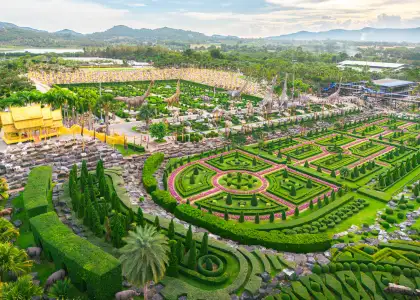
Known for its stunning landscape design and displays of breathtaking flora and structured statues of fauna by local artists, Nong Nooch Tropical Botanical Garden (a.k.a. Nongnooch Garden Pattaya) is the largest botanical garden in Southeast Asia that combines lush gardens with Thai cultural experiences.
This destination in Chonburi province is the perfect spot for a short break as it offers various activities and attractions to keep you immersed in nature. Have a stroll across its many European-themed gardens, explore its massive plant collection, or witness exciting Thai cultural performances from traditional dances to martial arts and elephant shows.
For families, you can also explore their Dinosaur Valley, which displays life-size dinosaur sculptures, or climb up the Skywalk, where you can see stunning panoramic views of the garden from above. Nong Nooch Tropical Botanical Garden is more than just a garden, it’s a full-scale experience packed with cultural immersion, entertainment, and education.
Location: 34/1 Moo 7 Najomtien District, Sattahip, Chonburi 20250 Thailand
Operation Hours: 8 AM to 6 PM
Admission Fee: THB600 (Adult) and THB400 (Child). You can buy tickets via their website or on Klook. They also offer packages that include show tickets and access to a sightseeing bus. Learn more here.
Follow them on Facebook, X (Formerly Twitter), and Instagram.
Entopia (Malaysia)
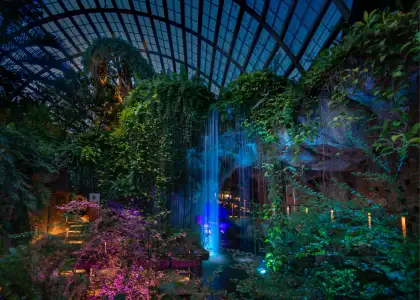
This nature discovery center, located in Penang, is the world’s first tropical butterfly and insect sanctuary. Today, it has transformed into an immersive experience in the world of the creepy crawlies and nature that features an open-air living garden, an indoor discovery center filled with interactive exhibits and educational zones, as well as architectural wonders, specifically the largest vertical garden in Malaysia!
Another unique attraction is Entopia by Night, which highlights the beauty of nature after dark. Here you can live your “Avatar” dreams by exploring the world’s first Biofluorescent Garden filled with vibrant flora and fauna that glow under ultraviolet light. You can also experience bioluminescent exhibits and dine at the Biofluorescent Odyssey for a one-of-a-kind dining experience where culinary artistry intertwines with nature’s brilliance.
Location: 830 Jalan Teluk Bahang, 11050 Penang, Malaysia
Operation Hours: 9 AM to 6 PM daily and 7 PM to 10 PM for Entopia by Night every Thursday to Sunday.
Admission Fee: Day tickets start from RM75 (Adult) and RM65 (Child) while night tickets are RM40 (Adult) and RM30 (Child). Tickets can be purchased onsite or online.
Follow them on Facebook, X (Formerly Twitter), and Instagram.
Masungi Georeserve (Philippines)
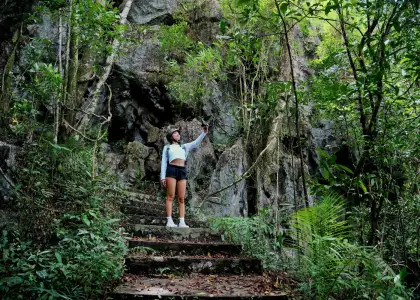
Just an hour’s drive from Manila is this conservation area and rustic rock garden tucked in the rainforests of Rizal. Masungi Georeserve may be popular for its hiking trails and IG-worthy rope hammock, but it also has a thoughtfully designed native garden home to some of the most beautiful flora species in the country.
It’s definitely worth the visit if you’re looking for a more adventurous nature escape, as you can turn flower viewing into a game of “I Spy” as you try and spot all the amazing flower species dotting its exciting trails.
And yes, there are several unique trail experiences such as the Discovery Trails, where visitors can get up close with the karst terrain, and the Legacy Trails, where you can acquire firsthand experiences in branch pruning, weeding, mulching, compost circle building, and tree planting.
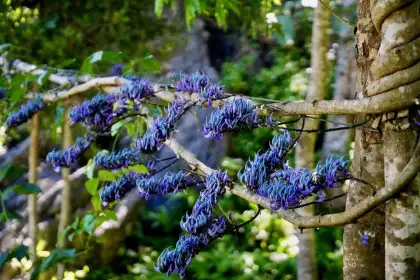
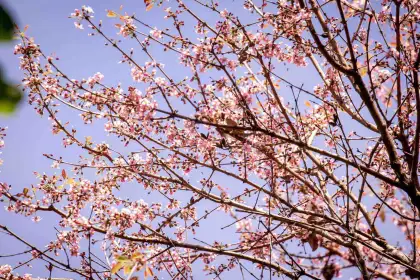
Location: Kilometer 47, Marcos Highway, Baras, Rizal, Philippines, 1970
Operation Hours: 8 AM to 4 PM, Tuesdays to Sundays
Admission Fee: Conservation fees start from P1,500 on weekdays and P1,800 on weekends. You can check the website to request to visit and to view fees for specific experiences.
Follow them on Facebook, X (Formerly Twitter), and Instagram.
Arroceros Forest Park (Philippines)
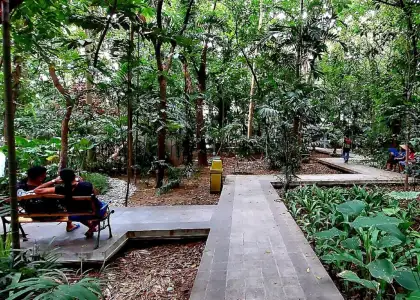
Often referred to as “Manila’s last lung,” this park is the capital’s only urban forest. Located along Antonio Villegas Street in Ermita, this 2.2-hectare park was established in 1993 and offers a rare pocket of greenery perfect for a quick nature escape from the city.
The park boasts over 3,500 trees of over 60 species, and despite its modest size, it also features a variety of ornamental plants and serves as a habitat for various bird species.
More than a nature haven, Arroceros Forest Park is a place brimming with historical significance as the park’s grounds date back to the Spanish colonial period and it was originally the site of a bustling market for Chinese traders in the 16th century. Throughout history, it has transformed into a military garrison as well as the headquarters of the Department of Education, before finally becoming a park.
If you’re looking for a breather from the hustle and bustle of city life, definitely consider taking a stroll within this urban oasis.
Location: 659 A Antonio Villegas St, Ermita, Manila, 1000 Philippines
Operation Hours: 6 AM to 5 PM daily.
Admission Fee: Free
Follow them on Facebook.
Tai Po Waterfront Park (Hong Kong)
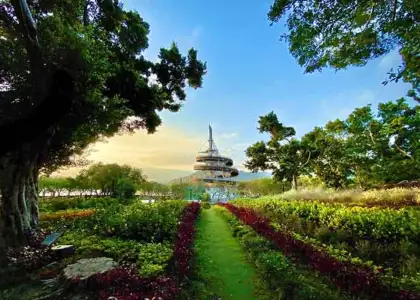
Whether you’re looking for a relaxing retreat or a chance to stretch those limbs through sports, Tai Po Waterfront Park offers a wide range of amenities for an enjoyable day under the sun.
The park boasts a diverse collection of thematic gardens that showcase a variety of plant species. Another one of its standout features is the Spiral Lookout Tower which stands at 32.4 meters, providing panoramic views of Tolo Harbour and the surrounding countryside. It also has a variety of facilities including the Insect House, which serves as a museum for different insect species; Hong Kong’s only model boat pool, an amphitheater, and expansive lawns ideal for picnics and kite-flying.
The best part about this destination is you can enjoy all of them for free!
Location: Dai Fat Street, Tai Po, New Territories
Operation Hours: Open 24 hours. Some facilities may have different opening times. For more information, click here.
Admission Fee: Free
Find out more here.
Victoria Peak Garden (Hong Kong)
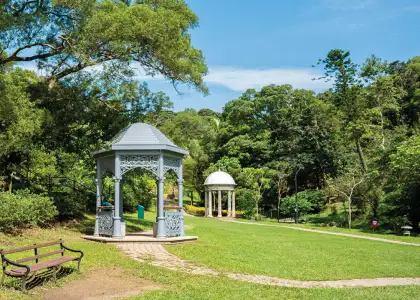
Originally the site of the Hong Kong governor’s Mountain Lodge summer residence, Victoria Peak Garden is a public open space with winding paths, sprawling lawns, and pagodas. This destination provides a serene escape from the bustling city, nestled atop Mount Austin on Hong Kong Island. Despite being located in one of the most touristy spots in the city, the garden remains tranquil and is ideal for relaxing strolls, picnics with the family, or even a fun play date with your pets.
The garden showcases Victorian-style elements, from the charming gazebos to wrought-iron fences and stone statues. It also has a fantastic lookout point which provides stunning views of Victoria Harbour, as well as the western and southern parts of the island.
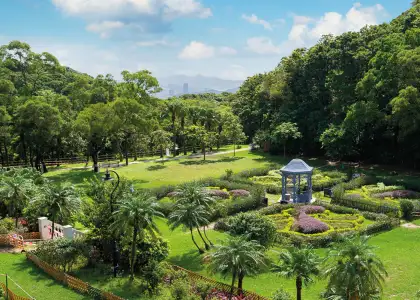
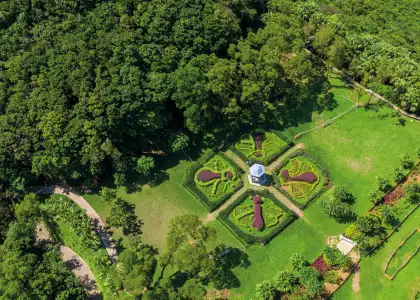
Location: Mount Austin Road, The Peak, Hong Kong Island
Operation Hours: Open 24 hours, but take note of Peak Tram and bus schedules.
Admission Fee: Free. You can either hike, take a car, taxi, or bus, or the Peak Tram to get here. Tram fees will apply. Learn more about it here.
Get the latest curated content with The Beat Asia's newsletters. Sign up now for a weekly dose of the best stories, events, and deals delivered straight to your inbox. Don't miss out! Click here to subscribe.

















